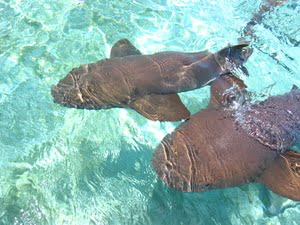When students hear ‘Black History Month’, we immediately think of the efforts of Dr. King, Rosa Parks, and of SNCC and other civil rights activists groups. And we should; their rubric for peaceful protest and ‘boy-cott’ is unparalleled in history, so far as I’ve seen.
We might also think of the suffering of enslaved Americans; now there’s a role model for courage, fortitude and amazing physical, mental and emotional endurance. I’m convinced that these people were endowed with a vitality that borders upon the superhuman, to have been able to withstand the atrocities wrought upon their bodies and souls.
But even these awesome accomplishments don’t even begin to tell the story of the Black contribution to our entire way of life. All cultures and peoples have enhanced the quality of life; in science, arts, music, education, mathematics, government, literature, medicine. But when a group is demeaned and down-trodden, those achievements come at a very high cost. This innate perseverance has enabled the Black community to produce some work that borders on the miraculous, especially considering the social handicaps under which it was produced. Adversity has given extra value to the gifts our society has received.
When I teach Black History, I use a wide angle lens that encompasses not simply the Civil rights movement, but the contribution of the Black community in every aspect of life. I’ve prepared a syllabus if you will of materials, resources and experiences that my students enjoy in our celebration of the Black community. I’ve designed it as an outline.
Science
George Washington Carver -(biologist) He gave us many things, but most memorable to students is his engineering efforst wtith the peanut and soy bean as edible for human consumption.
Peanuts-
We brainstorm a list of all the products we would not have without peanuts.
We design a poster from this data.
We create a diorama of GWC’s laboratory
We sample some tasty and healthy products made from peanuts.
Soybeans-
We research the use of synthetic fuels made from soy products.
We examine the importance of soy in our diets.
We calculate the nutrients in soy.
We consume soy products (soymilk and tofu) We conduct experiments to see if our health improves.
Five Notable Inventors,Wade Hudson; 1995- Scholastic Books
We create a mobile of items or representations of the technology and products we enjoy, thanks to these inventions.
We debate, ‘Would these inventors be better recognized had they been white?’
Matthew Henson first to reach the north pole (biologist)
We map the his journey and the region of the North Pole
Military
We watch Glory(54th Massachusetts all black regiment in Civil War) and companion documentary on the regiment.
We read:
Come all You Brave Soldiers
Fallen Angels Walter Dean Myers (Viet Nam) (Black soldiers in the Revolutionary War) Clinton Cox; 2002- Scholastic
We study
Crispus Attucks- -Killed in Boston Massacre
Benjamin O.Davis- WWII hero, founded Tuskegee Airmen
Literature and Authors -We read several of these books; we design book covers or posters describing the works. We display them.
Christopher Paul Curtis
Bud, Not Buddy (Newbery Medal)
The Watson’s go to Birmingham (Newbery medal) )
Sounder
Langston Hughes (poet)
Maya Angleou (I know Why the Caged Bird Sings)
Dick Gregory (humorist, author)
Harper Lee-To Kill a Mockingbird
Lillian HelmanA Raisin in the Sun (play)
Elisa CarboneStorm Warriors (black surfmen at the Pea Island life-saving station))
Music and Dance– We view the productions and listen to recordings of the music. We explore the music in our arts classes.
Marian Anderson
Alvin Ally
Gregory Hines
Scott Joplin (ragtime composer) The Entertainer
Duke Ellington
Ella Fitzgerald
Mahailia Jackson
Louis Armstrong
Charlie Parker
Count Basie
John Coltrane
BB King
Jimi Hendrix
Muddy Waters
Ben Harper
Diana Ross
Bob Marley
Nat King Cole
Sammy Davis Jr.
Aretha Franklin
Natalie Cole
Actors – We view some of their work
Sidney Poiter (Guess Who’s Coming to Dinner)
Cicely Tyson
Morgan Freeman (Driving Miss Daisy)
Danny Glover (Places in the Heart)
Whoopie Goldberg, Oprah Winfrey (The Color Purple)
Samuel Jackson
Laurence Fishburne – (Tuskegee Airmen, Othello)
Sports –
Jackie Joiner
Jackie Robinson
Willie Mays
Henry Aaron
Jessie Owens
Joe Louis
Muhammed Ali
Thurgood Marshall -chief justice, supreme court
Rev. Jesse Jackson- statesman
Ralph Bunche- Nobel Peace Prize
Fannie Lou Hammer– humanitarian
Malcolm X- militant spokesman
A. Philip Randolph- labor leader
As a class, we choose a black American on whom to write a biography. We map the locations related to the information we gather. We develop a pictorial time line of the data also. We collect artifacts and visuals.
We conclude our unit with ‘museum’ we’ve created, displaying the materials we made. We play the music and set out any artifacts, books and movies we’ve used. We present our biography in a first person, dressed as the person we’ve studied (living ‘Wax Museum’, we call it.)
This list is by no means definitive; it’s just a springboard to start from. I’ve noticed time and again that the work of the black citizen is so frequently overshadowed by the notice and attention given to white counterparts (whose contribution may actually have been inferior).
You have to really dig to find the real truth behind the black contribution. I have always found Public Broadcasting Services (PBS) to be the most objective and reliable source of information. I think it’s time for some huge revisions in mainstream history texts.



